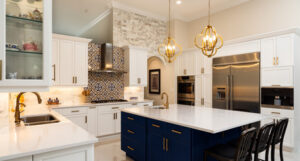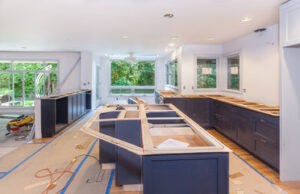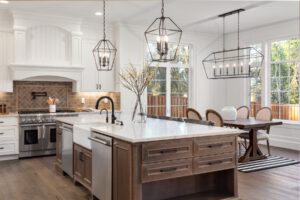Your kitchen is the heart of your home. It’s also one of the top home improvement projects that adds value if you plan to sell your property.
Atlanta Kitchen Remodeling is an opportunity to update or upgrade worn-out surfaces, materials, and appliances. It can also make the room more functional and enjoyable to use.
When planning a kitchen remodel, the layout is one of the most important aspects to consider. The right kitchen layout can improve workflow and make the space more functional for everyday use. A well-balanced layout can also make the room more inviting to guests and family members.
A popular choice for homeowners is the L-shaped kitchen layout. This design features work zones on two adjacent walls that run perpendicular to each other. This allows for ideal appliance placement and helps reduce traffic in the kitchen by making it easy to move between zones. This layout can be adapted to any size kitchen and even works well in open floor plans.
Another option for a smaller space is the one-wall kitchen layout, which features counters and cabinets lined up against a single wall. This is an efficient kitchen design for small homes, apartments and lofts and keeps everything within reach. However, it is not as efficient for a larger space and does not follow the classic work triangle format. An island can improve this kitchen layout and provide extra countertop space for food prep.
An alternative to the L-shaped kitchen is a U-shaped layout, which also works in any size kitchen. This layout surrounds the cook with workspace on three sides and offers seamless storage and countertop space. It can be adapted to any size room and eliminates traffic by ensuring that non-cooks do not have to walk through the kitchen. It can also be enhanced with a peninsula or island to add even more functionality.
Regardless of the type of kitchen you have, it’s always a good idea to optimize storage space. This can be done by removing upper cabinetry on a few walls and installing shelving. Additionally, using drawers rather than standard shelves can help maximize storage and make it easier to see and find items in the cabinets.
Cabinets
Cabinetry is the backbone of a kitchen. It organizes storage space, defines the room’s aesthetic and serves as a focal point. It also provides the opportunity for integrating unique cabinet accessories and features that improve kitchen functionality. Adding an integrated charging station to keep electronics and cords organized is one example. Another is placing a pull-out cutting board directly above the sink, eliminating the need to move items from cabinet to counter and back again.
Custom cabinets provide the greatest flexibility, allowing them to be sized to fit the specific dimensions of a kitchen and its layout. However, this option will increase the overall cost of a remodel. For homeowners on a budget, stock or semi-custom cabinets may offer the best value.
Stock cabinets are typically built using face-frame construction, in which the cabinet frame is enclosed on five sides and a door is attached to the face of the sixth side. They’re available in a wide variety of colors and textures and can be designed to match or complement other design elements such as countertops, backsplashes, moldings, islands and other custom pieces.
Cabinetry is often described in terms of width-height-depth, with the dimension for a wall cabinet being 18 inches (460 mm) wide, 36 inches (910 mm) high and 12 inches (300 mm) deep. However, cabinet height can vary from 10 to 14 inches (254 to 355 mm), depending on the style. A higher height can be beneficial for taller cooks, but it may require more crouching to reach lower cabinets. Many kitchens are moving away from doors and toward drawers for better accessibility and to create a less cluttered look. This also helps to minimize the risk of breakage of glassware and other delicate items.
Countertops
Countertops are more than just a surface for placing food and objects, they also add aesthetics to the kitchen. They come in a variety of materials and styles, so it is important to understand the pros and cons of each before making a decision. For example, granite is popular due to its durability and strength; it resists heat and can stand up to abrasive damage. However, it can be expensive and requires professional installation.
Another popular countertop option is laminate. It is more affordable than natural stone and is available in a wide array of colors and patterns to match any kitchen design. While it can be durable, it can be prone to stains and needs to be regularly resealed. Stainless steel is another alternative to consider, as it provides a modern look and is heat resistant. However, it can be prone to fingerprints and water spots, and it scratches easily.
Backsplashes are an excellent way to bring another element of style into the kitchen, and they serve a practical purpose by keeping water, grease and other grime from damaging the walls behind the sink and countertops. There are many different options to choose from, but it is important to keep in mind that a complex backsplash will add to the overall cost of your project.
The key to a successful kitchen remodel is planning ahead and staying within your budget. It is easy to get caught up in the excitement of the project and overspend, so it is important to create a comprehensive budget before getting started. This will help you avoid having to cut corners or settle for a subpar remodel. It will also help you entice potential home buyers when it comes time to sell.
Appliances
Appliances are the first step in any kitchen remodel and a huge commitment as they’re the starting point for all other permanent features like custom cabinetry, countertops, backsplash and more. It’s important to test out the functionality of appliances before buying and to plan out their placement based on how you use your kitchen.
During your design process, it’s also important to consider how the functionality of your appliances will change over time. For example, a trend now is to add smart appliances with built-in Wi-Fi that can connect to an app so you can control your fridge or oven. Some even include food-preservation settings and a hydration feature to keep track of how much water you’re drinking.
It’s also important to consider the durability of your appliances, especially if you’re considering wood finishes. Wood is beautiful and natural, but it can scratch and ding with heavy kitchen wear and tear. It’s a good idea to consider choosing metals and plastics for your appliances instead so they can hold up against everyday use without showing the wear.
Finally, it’s also important to plan for proper lighting in your kitchen. You’ll want to install task lighting under cabinets and over the countertop to help you see your work better. Pendants are great for islands and other counters with no low cabinets, while recessed ceiling fixtures and wall sconces can be installed over sinks to create ambient light for your entire kitchen.
Kitchen remodeling is an opportunity to transform your space into a space that’s uniquely your own. It’s also a great way to increase the value of your home and create a room that’s perfect for cooking, eating and gathering with family and friends.
Lighting
A kitchen needs a good mix of lighting options to function properly. Layered lighting creates an ambiance, makes it easy to work in the space, and helps set the mood when entertaining.
Your first base layer is ambient light, a soft overhead illumination that fills the room. This is typically provided by ceiling fixtures like recessed lights or surface-mounted fixtures. Ambient lighting is also supplemented by natural light through windows during the day.
The second layer is task lighting, which is used to illuminate specific areas where you perform work in the kitchen. This includes spaces like your countertops, sink, and stovetop. This type of lighting is often provided by under cabinet or pendant lights, as well as directional downlights.
Accent lighting, on the other hand, accentuates design features and creates a more dramatic effect. This can be done with a variety of fixtures, from decorative pendants to colorful string lights by the window.
Lighting can be the deciding factor in how functional and welcoming your new kitchen feels. Getting it right is essential and should be considered in the early stages of your kitchen remodel, rather than as a last-minute add-on.





 Wall Stenciling
Wall Stenciling